语言学教程
《语言学教程》中文笔记(完整)
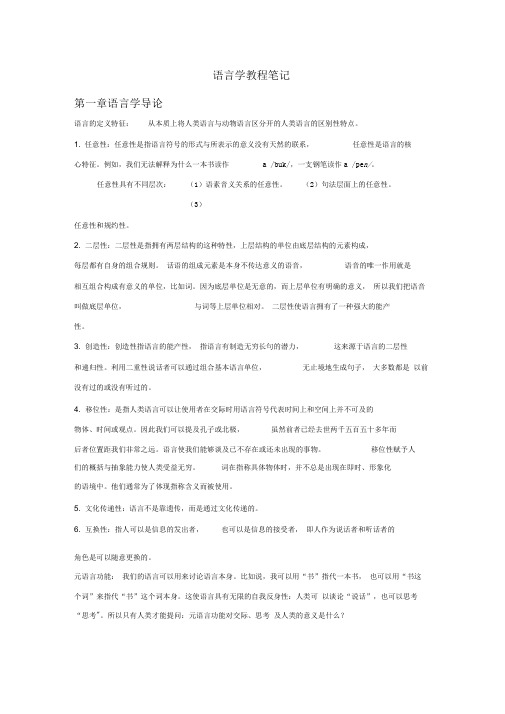
语言学教程笔记第一章语言学导论语言的定义特征:从本质上将人类语言与动物语言区分开的人类语言的区别性特点。
1. 任意性:任意性是指语言符号的形式与所表示的意义没有天然的联系,任意性是语言的核心特征。
例如,我们无法解释为什么一本书读作 a /buk/,一支钢笔读作a /pe n/。
任意性具有不同层次:(1)语素音义关系的任意性。
(2)句法层面上的任意性。
(3)任意性和规约性。
2. 二层性:二层性是指拥有两层结构的这种特性,上层结构的单位由底层结构的元素构成,每层都有自身的组合规则。
话语的组成元素是本身不传达意义的语音,语音的唯一作用就是相互组合构成有意义的单位,比如词。
因为底层单位是无意的,而上层单位有明确的意义,所以我们把语音叫做底层单位,与词等上层单位相对。
二层性使语言拥有了一种强大的能产性。
3. 创造性:创造性指语言的能产性,指语言有制造无穷长句的潜力,这来源于语言的二层性和递归性。
利用二重性说话者可以通过组合基本语言单位,无止境地生成句子,大多数都是以前没有过的或没有听过的。
4. 移位性:是指人类语言可以让使用者在交际时用语言符号代表时间上和空间上并不可及的物体、时间或观点。
因此我们可以提及孔子或北极,虽然前者已经去世两千五百五十多年而后者位置距我们非常之远。
语言使我们能够谈及已不存在或还未出现的事物。
移位性赋予人们的概括与抽象能力使人类受益无穷。
词在指称具体物体时,并不总是出现在即时、形象化的语境中。
他们通常为了体现指称含义而被使用。
5. 文化传递性:语言不是靠遗传,而是通过文化传递的。
6. 互换性:指人可以是信息的发出者,也可以是信息的接受者,即人作为说话者和听话者的角色是可以随意更换的。
元语言功能:我们的语言可以用来讨论语言本身。
比如说,我可以用“书”指代一本书,也可以用“书这个词”来指代“书”这个词本身。
这使语言具有无限的自我反身性:人类可以谈论“说话”,也可以思考“思考"。
《语言学教程》Chapter-2-ics

语法
语法
语法是语言中词和句子的结构规律和 规则,是语言的组织原则。语法包括 词法和句法两部分。词法研究词的内 部结构和变化规律;句法研究短语和 句子的结构规律和规则。
语法的特点
语法具有抽象性、生成性、层次性和 系统性等特点。抽象性是指语法规则 是对语言中具体实例的抽象概括;生 成性是指语法能够生成无限多的合乎 语法的句子;层次性是指语法结构分 为若干层次,不同层次之间存在递归 关系;系统性是指语法规则相互联系 、相互制约,形成一个完整的系统。
新的词汇、表达方式和语法结构等可能会随着时间的推移而出 现,丰富和发展语言的表达和沟通功能。
05
语言与社会文化的关系
语言与文化的关系
语言是文化的重要组成部分,是文化 传承和发展的载体。语言中蕴含着丰 富的文化信息,反映了特定民族的历 史、传统、信仰、价值观等。
语言与文化相互影响,语言使用中的 词汇、语法、表达方式等都受到文化 的影响,同时语言也影响了人们对世 界的认知和表达方式。
语音的生理属性
语音的生理属性包括发音机制和听觉机制。发音机制包括呼吸系统、声源系统、调制系统 和共鸣系统;听觉机制包括听觉接收器和大脑处理声音信息的过程。
词汇
词汇
词汇是语言中所有词的总和,是语言的建筑材料。词汇由词和固定词组构成,包括实词和虚词两大类。实词表示事物 、概念、动作等具体内容;虚词表示语法关系和语气等抽象内容。
语法的作用
语法在语言中起着非常重要的作用。 首先,语法保证语言的正确性和规范 性,使人们能够准确地表达思想、传 递信息。其次,语法使语言具有生成 性,能够生成无限多的合乎语法的句 子。最后,语法使语言具有开放性, 能够吸收外来文化和方言的影响,不 断丰富言演变的原因
新编语言学教程课件

不同语言之间的接触会导 致语言借用、语言替代等 现象,如汉语中的外来词 。
STEP 03
语言消亡与保护
一些弱势语言可能会逐渐 消亡,因此语言的保护和 传承变得尤为重要。
不同语言的混合使用可能 导致新的语言或方言的形 成,如普通话的形成。
Part
04
语言与社会文化
语言与文化的关系
语言是文化的重要组成部分, 是文化传承和发展的载体。
语法的演变
语法的发展变化与语言的发展变 化密切相关,随着社会的变化和 语言的演变,语法也在不断地演 变。
语义
语义的分类
语义可以分为词汇意义、语法意义和语境意义等,词汇意义是词汇的基本意义,语法意 义是句子结构所表Байду номын сангаас的意义,语境意义则是特定语境中产生的附加意义。
语义的演变
语义的发展变化与语言的发展变化密切相关,随着社会的变化和语言的演变,语义也在 不断地演变。
机器翻译
探讨机器翻译的原理、算法和应用,以及如何提高翻 译的准确性和效率。
人机交互
分析人机交互中语言的作用,如语音助手、智能客服 等,以及如何设计更自然的人机对话界面。
THANKS
感谢您的观看
Part
05
语言学应用
语言教学
语言教学方法
探讨不同语言教学方法的优缺点,如语法翻译法 、直接法、听说法等。
语言教材编写
介绍如何根据教学目标和学生的需求,编写有针 对性的语言教材。
语言技能培养
讨论如何培养学生的听、说、读、写、译等语言 技能,以及如何评估学生的学习成果。
语言规划与政策
语言政策制定
词汇的意义
词汇的意义包括概念意义和语境意义,概念意义是 词汇的基本意义,而语境意义则是在特定语境中产 生的附加意义。
语言学教程

语言学教程
语言学教程是一门涉及语言的科学研究。
它研究语言的结构、用途和演化。
在语言学教程中,我们将学习各种语言学的重要概念和理论。
这些概念包括语音学、语法学、语义学和语用学。
通过学习语言学,我们可以更好地理解人类语言的本质和功能。
首先,让我们来了解语音学。
语音学研究语音的产生、传播和感知。
它研究语音的音素、音节和音素组合。
在语音学中,我们将学习如何描述和分类语音,以及不同语音之间的相似和差异。
接下来,是语法学。
语法学研究语言的结构和规则。
它研究词汇、句法和句子结构。
在语法学中,我们将学习如何分析句子的结构,并理解不同语言中的语法规则。
然后,是语义学。
语义学研究语言的意义和符号。
它研究单词和句子的意义以及语言中的逻辑和推理。
在语义学中,我们将学习如何分析和解释语言的意义,以及语言中的含义和推理。
最后,是语用学。
语用学研究语言在特定上下文中的使用和交流。
它研究言语行为、会话结构和语言交际。
在语用学中,我们将学习如何根据特定情境和目的选择适当的语言形式,以及如何理解和解释他人的意图和信息。
通过学习这些语言学的概念和理论,我们可以更好地理解语言的本质和功能。
无论是学习一门新的语言,还是研究语言的结
构和演化,语言学都为我们提供了强大的工具和框架。
让我们一起探索语言学的世界吧!。
语言学教程

语言学教程语言学是研究语言的科学,它探究语言的结构、语言的起源与演化、语言的使用和语言的变化,以及语言与思维、文化之间的关系。
它是一门跨学科的学科,融合了哲学、心理学、人类学、社会学等多个领域的知识。
本文将向您介绍语言学的基本概念、重要理论以及相关研究方法。
一、语言学的基本概念1. 语言的定义:语言是人类用来交流思想、观念和情感的系统,它通过声音、文字等符号来表达。
2. 语言的特征:语言具有符号性、任意性、双向性、组合性、结构性和文化性等特征。
3. 语言的层次:语言可以分为语音、词汇、语法和语义等层次,每个层次都有其特定的研究对象和方法。
二、语言学的重要理论1. 结构主义理论:结构主义强调语言的内部结构和规则,通过对语言的各个层次进行分析,揭示其规律和模式。
2. 生成语法理论:生成语法理论关注语言的生成和理解过程,通过分析语言的语法结构来解释言语的表达和理解。
3. 语用学理论:语用学研究语言在实际交际中的使用,探讨言语行为的目的和效果,关注言语的意义和语境的影响。
三、语言学的研究方法1. 语言调查:通过调查问卷、访谈等方式来收集关于语言使用和语言知识的数据,以了解语言的变化和语言规律。
2. 语料库研究:语料库是大规模收集和记录的语言材料,通过分析语料库中的语言数据,揭示语言的规律和特点。
3. 实验研究:通过实验设计和数据分析,观察和确定语言的规律和模式,验证语言学理论。
四、语言学的研究领域1. 语音学:研究语音的产生、传播和感知等问题。
2. 词汇学:研究词汇的形成、构词法和词义等问题。
3. 句法学:研究句子的结构和语法规则等问题。
4. 语义学:研究语言单位和语言联结的意义和表达等问题。
五、语言学的应用领域1. 语言教学:语言学为语言教学提供理论依据和教学方法,帮助学习者掌握语言技能和提高语言能力。
2. 语音识别和语音合成:语音技术在语音识别和语音合成领域的应用,提高了人机交互的效率和体验。
3. 机器翻译:语言学的研究成果为机器翻译的发展提供了基础,帮助人们解决跨语言交流的障碍。
语言学教程(第五版)英文版 读书笔记
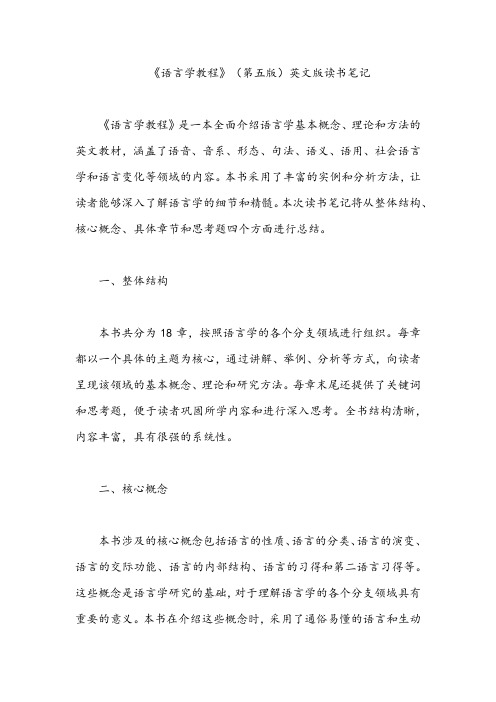
《语言学教程》(第五版)英文版读书笔记《语言学教程》是一本全面介绍语言学基本概念、理论和方法的英文教材,涵盖了语音、音系、形态、句法、语义、语用、社会语言学和语言变化等领域的内容。
本书采用了丰富的实例和分析方法,让读者能够深入了解语言学的细节和精髓。
本次读书笔记将从整体结构、核心概念、具体章节和思考题四个方面进行总结。
一、整体结构本书共分为18章,按照语言学的各个分支领域进行组织。
每章都以一个具体的主题为核心,通过讲解、举例、分析等方式,向读者呈现该领域的基本概念、理论和研究方法。
每章末尾还提供了关键词和思考题,便于读者巩固所学内容和进行深入思考。
全书结构清晰,内容丰富,具有很强的系统性。
二、核心概念本书涉及的核心概念包括语言的性质、语言的分类、语言的演变、语言的交际功能、语言的内部结构、语言的习得和第二语言习得等。
这些概念是语言学研究的基础,对于理解语言学的各个分支领域具有重要的意义。
本书在介绍这些概念时,采用了通俗易懂的语言和生动的实例,使读者能够轻松地理解和掌握这些概念。
三、具体章节第一章:语言的性质本章介绍了语言的定义、语言与文化的关系以及语言的多样性。
重点讲解了语言的符号性质和非任意性,强调了语言与文化之间的密切联系以及语言在不同文化中的差异。
此外,本章还介绍了语言在人类生活中的重要性以及语言习得的必要性。
第二章:语言的分类本章介绍了语言的分类方法,包括形态分类法和功能分类法。
形态分类法主要依据语言的词汇和语法特征进行分类,而功能分类法则更注重语言在实际交际中的作用。
本章还详细介绍了世界上各种语言的分布情况以及汉语和英语的分类地位。
第三章:语言的演变本章介绍了语言演变的定义和原因,分析了语言演变的规律和趋势。
重点讲解了语音、语法和词汇方面的演变,并通过实例展示了不同语言在不同历史时期的演变过程。
此外,本章还介绍了语言演变的研究方法和意义。
第四章:语言的交际功能本章介绍了语言的交际功能,包括信息传递、情感表达、社交联系和权力关系等。
《语言学教程》学习辅导

《语言学教程》学习辅导目录1. 课程概述 (3)1.1 课程目标和学习内容 (4)1.2 教学方法和课程安排 (5)1.3 参考书目和学习资源 (6)2. 语言学基本概念 (8)2.1 语言是什么? (10)2.2 语言学研究领域 (11)2.3 语言学方法 (13)3. 语音学 (14)3.1 声学基本原理 (15)3.2 声音的分类和特征 (17)3.3 连续声音和离散声音,音素和音位 (18)3.4 音阶系统和语调 (19)4.1 词语的结构和分类 (22)4.2 词汇的意义和语义 (23)4.3 词汇演变和词缀 (24)4.4 词汇来源和借词 (25)5. 句法学 (26)5.1 句子的基本结构 (28)5.2 句子成分和语篇 (30)5.3 语句类型的分类 (31)5.4 句子的修饰和复合 (32)6. 语义学 (34)6.1 词义和概念 (35)6.2 语义关系和意义的同一性 (36)6.3 隐含义和日常意义 (37)6.4 语义学研究方法 (38)7.1 语言与社会 (41)7.2 语言变化与社会变迁 (42)7.3 语言偏见与语言权力 (44)7.4 多元文化和语言 (45)8. 应用语言学 (46)8.1 第二语言习得 (48)8.2 文本分析 (50)8.3 机器翻译 (51)8.4 语言治疗 (53)9. 语言学研究方法 (54)9.1 描述性方法 (56)9.2 实验性方法 (57)9.3 比较方法 (58)9.4 历史方法 (60)1. 课程概述要对语言学有一个全面、深入的理解,我们有必要从课程的概述中了解语言学的基本概念、研究方法和理论框架。
本学习辅导旨在帮助学生建立起对语言学这门学科的系统性认识,并能够将所学的理论应用于实际的语言分析中。
语言学的定义与研究的范围:学生将首先了解到语言学的基本定义,即研究语言的性质、结构、功能和发展规律的科学。
课程将涉及语言学从词汇学到语法学的各个分支。
语言学教程第五版重点笔记

语言学教程第五版重点笔记语言学是研究语言的科学,它涉及到语言的结构、发展、使用和功能等方面。
本篇笔记将重点总结语言学教程第五版的内容,包括语言学的基本概念、语音学、形态学、句法学、语义学和语用学等。
1.语言学的基本概念-语言:人类沟通的主要方式,具有符号性、规则性和交际性。
-语言的属性:可描述为音、形、意的体系,通过语音、文字等媒介来传递信息。
-语言与方言:方言是指在某个地区或群体中使用的语言变体,而语言是方言的高级别组织。
-语言的历史演变:语言随着时间推移会发生变化,并分化成不同的语言家族和亚族。
2.语音学-语音:语言中最小的语言单位,由音素构成。
-音位和音素:音位是在特定语言中具有区别词义的最小音段,而音素是语音学上对音位的理论概念。
-发音:语音的实际发声过程,包括发音器官的运动和声带的振动。
-音系:特定语言中的音位组合,反映了该语言中的音素系统。
3.形态学-形态:语言中用来构成词的基本单位。
-词的形态结构:词根、词缀和词尾等构成词的部分。
-词的形态类型:自由词和词素词。
-词类:词根或词素所属的语法类别,如名词、动词、形容词等。
4.句法学-句子:语言中最小的完整意义单位。
-短语:句子的组成部分,由词汇构成。
-句法关系:短语之间的语法关系,如主谓关系、动宾关系等。
-句法结构:句子的组织方式,包括短语结构和依存结构。
5.语义学-语义:语言中词、短语和句子所表达的意义。
-词义学:研究词汇的意义,包括词义分类、词义变化等。
-句义学:研究句子的意义,包括句子的真值条件、逻辑关系等。
6.语用学-语用:语言使用的实际情境。
-言外之意:在语言表面之下所包含的意义。
-会话分析:研究对话和交际行为的学科。
以上是《语言学教程》第五版的重点内容。
通过学习这些知识,我们可以更深入地了解语言的结构和使用规律,从而更好地理解和运用语言。
语言学教程复习资料胡壮麟
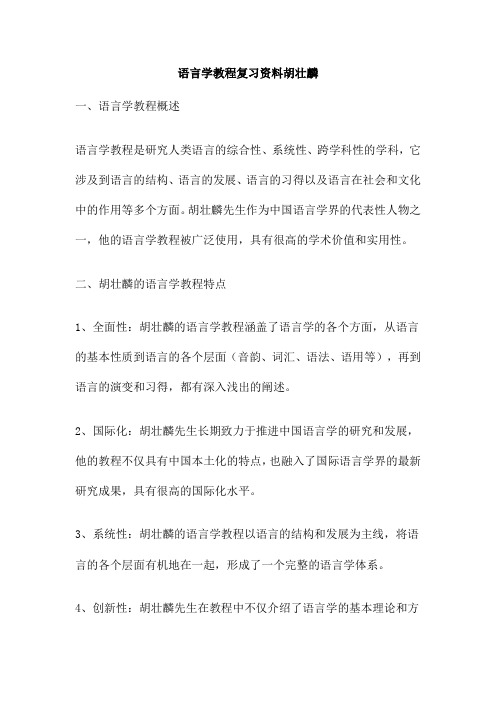
语言学教程复习资料胡壮麟一、语言学教程概述语言学教程是研究人类语言的综合性、系统性、跨学科性的学科,它涉及到语言的结构、语言的发展、语言的习得以及语言在社会和文化中的作用等多个方面。
胡壮麟先生作为中国语言学界的代表性人物之一,他的语言学教程被广泛使用,具有很高的学术价值和实用性。
二、胡壮麟的语言学教程特点1、全面性:胡壮麟的语言学教程涵盖了语言学的各个方面,从语言的基本性质到语言的各个层面(音韵、词汇、语法、语用等),再到语言的演变和习得,都有深入浅出的阐述。
2、国际化:胡壮麟先生长期致力于推进中国语言学的研究和发展,他的教程不仅具有中国本土化的特点,也融入了国际语言学界的最新研究成果,具有很高的国际化水平。
3、系统性:胡壮麟的语言学教程以语言的结构和发展为主线,将语言的各个层面有机地在一起,形成了一个完整的语言学体系。
4、创新性:胡壮麟先生在教程中不仅介绍了语言学的基本理论和方法,还融入了自己的研究成果和见解,具有很强的创新性。
5、实用性:胡壮麟的语言学教程以实例和案例为基础,通过分析真实的语言材料,帮助学生理解和掌握语言学的理论和方法,具有很高的实用性。
三、复习资料推荐1、《新编语言学教程》:由胡壮麟先生主编,包含了语言学的基本理论和研究方法,是学习语言学的重要参考书之一。
2、《语言学纲要》:由叶蜚声、徐通锵先生主编,系统介绍了语言学的基本概念、基本原理和研究方法,是学习语言学的重要参考书之一。
3、《普通语言学教程》:由索绪尔先生著,介绍了语言学的基本概念、基本原理和研究方法,是学习语言学的重要参考书之一。
语言学复习资料一、语言学概述语言学是研究人类语言的学科,它涵盖了对语言的结构、功能、演变和应用等方面的研究。
语言学具有交叉性和综合性的特点,与心理学、社会学、人类学等学科有着密切的。
二、语言学的基本概念1、语言:语言是人们交际和表达思想的工具,是一种符号系统。
它由词汇、语法、语音等构成。
2、言语:言语是人们运用语言进行交际的过程,是个人表达思想的方式。
《语言学教程》中文笔记(完整)

语言学教程笔记第一章语言学导论语言的定义特征:从本质上将人类语言与动物语言区分开的人类语言的区别性特点。
1.任意性:任意性是指语言符号的形式与所表示的意义没有天然的联系,任意性是语言的核心特征。
例如,我们无法解释为什么一本书读作a /buk/,一支钢笔读作a /pen/。
任意性具有不同层次:(1)语素音义关系的任意性。
(2)句法层面上的任意性。
(3)任意性和规约性。
2.二层性:二层性是指拥有两层结构的这种特性,上层结构的单位由底层结构的元素构成,每层都有自身的组合规则。
话语的组成元素是本身不传达意义的语音,语音的唯一作用就是相互组合构成有意义的单位,比如词。
因为底层单位是无意的,而上层单位有明确的意义,所以我们把语音叫做底层单位,与词等上层单位相对。
二层性使语言拥有了一种强大的能产性。
3.创造性:创造性指语言的能产性,指语言有制造无穷长句的潜力,这来源于语言的二层性和递归性。
利用二重性说话者可以通过组合基本语言单位,无止境地生成句子,大多数都是以前没有过的或没有听过的。
4.移位性:是指人类语言可以让使用者在交际时用语言符号代表时间上和空间上并不可及的物体、时间或观点。
因此我们可以提及孔子或北极,虽然前者已经去世两千五百五十多年而后者位置距我们非常之远。
语言使我们能够谈及已不存在或还未出现的事物。
移位性赋予人们的概括与抽象能力使人类受益无穷。
词在指称具体物体时,并不总是出现在即时、形象化的语境中。
他们通常为了体现指称含义而被使用。
5.文化传递性:语言不是靠遗传,而是通过文化传递的。
6.互换性:指人可以是信息的发出者,也可以是信息的接受者,即人作为说话者和听话者的角色是可以随意更换的。
元语言功能:我们的语言可以用来讨论语言本身。
比如说,我可以用“书”指代一本书,也可以用“书这个词”来指代“书”这个词本身。
这使语言具有无限的自我反身性:人类可以谈论“说话”,也可以思考“思考”。
所以只有人类才能提问:元语言功能对交际、思考及人类的意义是什么?语言学的一些重要区别1.“描写式”和“规范式”描写式:客观系统地记录一种语言的模式和用法或变化。
语言学教程第一章ppt
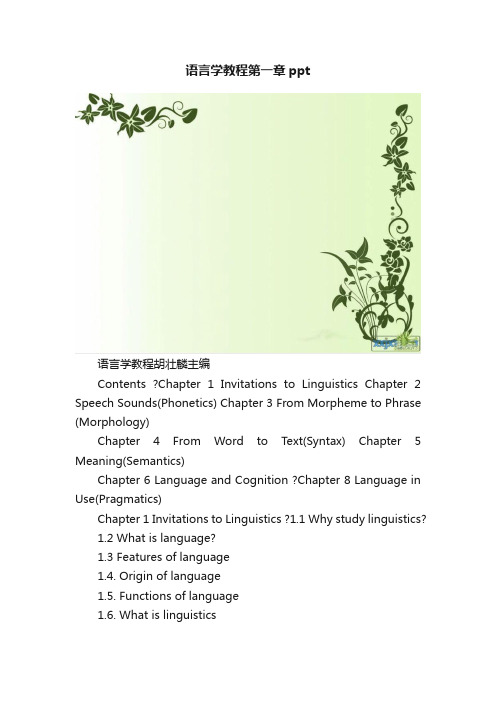
语言学教程第一章ppt语言学教程胡壮麟主编Contents ?Chapter 1 Invitations to Linguistics Chapter 2 Speech Sounds(Phonetics) Chapter 3 From Morpheme to Phrase (Morphology)Chapter 4 From Word to Text(Syntax) Chapter 5 Meaning(Semantics)Chapter 6 Language and Cognition ?Chapter 8 Language in Use(Pragmatics)Chapter 1 Invitations to Linguistics ?1.1 Why study linguistics?1.2 What is language?1.3 Features of language1.4. Origin of language1.5. Functions of language1.6. What is linguistics1.7 Main branches of linguistics1.8. Macrolinguistics1.9 Important distinctions in linguisticsLead-inQestion1: Other animals can beat us in many different ways, but what makes us superior to all of them?Qestion2: Why are children easy to undrstand their mother's tongue??Qestion3: Why do people in different social classes speak in different ways??Qestion4: Why is it "I love you" in English, but "私はあなたを愛して" in Japanese?1.2 What is language ?Language is a system of arbitrary vocal symbols used for human communication.__ by (英)沃德霍(Wardhaugh,R.)1.3 Design Features of languageArbitrarinessDualityCreativityDisplacement1.3.1 Arbitrariness ?Arbitrariness: the forms of linguistic signs bear no natural relationship to their meaning –Saussure.Eg: name,book,pen(1) Arbitrary relationship between the sound of a morpheme and its meaning.Eg: Hi, Aha,Hush, Hem, Hey.(2) Arbitrariness at the syntactic level: according to systemic-functionalists and American functionalists, language is not arbitrary at the syntactic level. In other words, syntax is less arbitrary than words.Eg: He came in and sat down.(3) Idiom is not arbitrary.Eg: apple-polisher, black sheep, a yellow dog.1.3.2 DualityDuality (double articulation)Lower level----sounds (meaningless Eg: Consonants and Vowels)Higher level----meaning (larger units of meaning Eg: word)A communication system with duality is considered more flexible than one without it, for a far greater number of messages can be sent.A small number of sounds can be grouped and regrouped into a large number of units of meaning (words), and the units of meaning can be arranged and rearranged into an infinite number of sentences. (we make dictionary of a1.3.3 CreativityPeculiar to human languages,users of language can understand and produce sentences they have never heard before, e.g. we can understand sentence like “A red-eyed elephant is dancing on the hotel bed”, though it does not describe a common happening in the world.Eg: 说曹操曹操到(not refer to Cao Cao himself)1.3.4 Displacement----Language can be used to refer to things, which are not present: real or imagined matters, in the past, present or future, or in far-away places.Eg: 911 events , New York1.4. Origin of language语言的起源是语言学的基本理论问题之一。
语言学教程第五版语言的论述。

语言学教程第五版语言的论述。
摘要:1.语言学教程第五版的概述2.语言的定义与分类3.语言的特性与功能4.语言学的研究方法5.语言学在实际应用中的重要性正文:【语言学教程第五版的概述】《语言学教程》第五版是一本关于语言学的经典教材,系统地介绍了语言学的基本概念、理论和方法。
该教程旨在帮助读者深入理解语言的本质、结构和演变规律,为进一步研究语言学提供坚实的基础。
【语言的定义与分类】语言是人类交际的一种符号系统,包括口头和书面形式。
根据不同的标准,语言可以分为多种类型,如世界语系、语域、语系、语族等。
不同类型的语言具有各自的特点和规律,研究这些规律有助于更好地理解人类的交际行为。
【语言的特性与功能】语言具有多种特性,如任意性、创造性、移位性、递归性等。
这些特性使语言能够表达丰富的意义和结构。
语言的功能包括交际、认知、社会、情感等多个方面,对于人类社会的发展和个体的成长具有重要意义。
【语言学的研究方法】语言学研究方法包括实证法、演绎法、比较法、结构分析法等。
这些方法为研究语言提供了不同的途径,使学者们能够从不同角度探讨语言的本质和规律。
【语言学在实际应用中的重要性】语言学在实际应用中具有广泛的应用价值,如教育、翻译、语言治疗、计算机科学等领域。
通过语言学的研究,人们可以更好地掌握语言规律,提高语言运用能力,促进跨文化交际和全球化进程。
同时,语言学的研究成果也有助于计算机更好地理解和处理自然语言,推动人工智能技术的发展。
总之,《语言学教程》第五版为读者提供了丰富的语言学知识,有助于我们深入理解语言的本质、结构和演变规律。
语言学教程
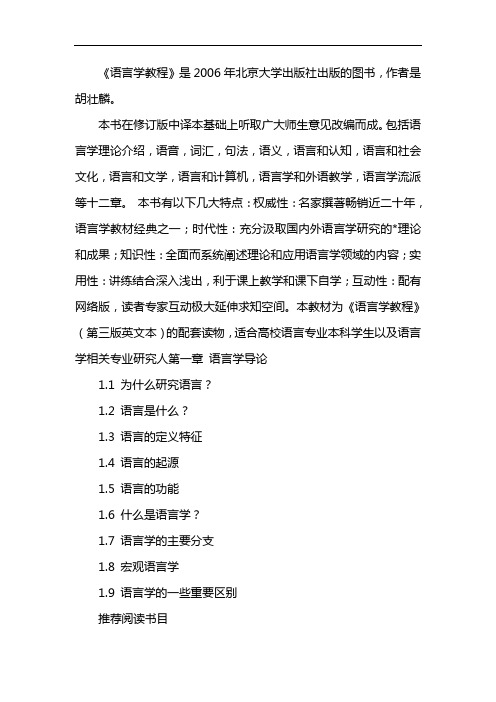
《语言学教程》是2006年北京大学出版社出版的图书,作者是胡壮麟。
本书在修订版中译本基础上听取广大师生意见改编而成。
包括语言学理论介绍,语音,词汇,句法,语义,语言和认知,语言和社会文化,语言和文学,语言和计算机,语言学和外语教学,语言学流派等十二章。
本书有以下几大特点:权威性:名家撰著畅销近二十年,语言学教材经典之一;时代性:充分汲取国内外语言学研究的*理论和成果;知识性:全面而系统阐述理论和应用语言学领域的内容;实用性:讲练结合深入浅出,利于课上教学和课下自学;互动性:配有网络版,读者专家互动极大延伸求知空间。
本教材为《语言学教程》(第三版英文本)的配套读物,适合高校语言专业本科学生以及语言学相关专业研究人第一章语言学导论1.1 为什么研究语言?1.2 语言是什么?1.3 语言的定义特征1.4 语言的起源1.5 语言的功能1.6 什么是语言学?1.7 语言学的主要分支1.8 宏观语言学1.9 语言学的一些重要区别推荐阅读书目问题与练习第二章语音2.1 发音2.2 辅音和元音2.3 语音学到音系学的过渡2.4 音系过程、音系规则和区别特征2.5 超音段特征推荐阅读书目问题与练习第三章词汇3.1 什么是词?3.2 词的构成3.3 词汇变化推荐阅读书目问题与练习第四章句法:从语词到篇章4.1 句法关系4.2 语法结构和成分4.3 句法功能4.4 范畴4.5 短语,小句和句子4.6 递归性4.7 句子之外推荐阅读书目问题与练习员使用。
另配有练习册、光盘及学习网站。
胡壮麟《语言学教程》(修订版)即第二版

胡壮麟《语言学教程》(修订版)第一部分各章节提纲笔记Chapter 1 Invitations to Linguistics1.1 Why study language?1. Language is very essential to human beings.2. In language there are many things we should know.3. For further understanding, we need to study language scientifically.1.2 What is language?Language is a means of verbal communication. It is a system of arbitrary vocal symbols used for human communication.1.3 Design features of languageThe features that define our human languages can be called design features which can distinguish human language from any animal system of communication.1.3.1 ArbitrarinessArbitrariness refers to the fact that the forms of linguistic signs bear no natural relationship to their meanings.1.3.2 DualityDuality refers to the property of having two levels of structures, such that units of the primary level are composed of elements of the secondary level and each of the two levels has its own principles of organization.1.3.3 CreativityCreativity means that language is resourceful because of its duality and its recursiveness.Recursiveness refers to the rule which can be applied repeatedly without any definite limit. The recursive nature of language provides a theoretical basis for the possibility of creating endless sentences.1.3.4 DisplacementDisplacement means that human languages enable their users to symbolize objects, events and concepts which are not present (in time and space) at the moment of conversation.1.4 Origin of language1. The bow-wow theoryIn primitive times people imitated the sounds of the animal calls in the wild environment they lived and speech developed from that.2. The pooh-pooh theoryIn the hard life of our primitive ancestors, they utter instinctive sounds of pains, anger and joy which gradually developed into language.3. The “yo-he-ho” theoryAs primitive people worked together, they produced some rhythmic grunts which gradually developed into chants and then into language.1.5 Functions of languageAs is proposed by Jacobson, language has six functions:1. Referential: to convey message and information;2. Poetic: to indulge in language for its own sake;3. Emotive: to express attitudes, feelings and emotions;4. Conative: to persuade and influence others through commands and entreaties;5. Phatic: to establish communion with others;6. Metalingual: to clear up intentions, words and meanings.Halliday (1994) proposes a theory of metafunctions of language. It means that language has three metafunctions:1. Ideational function: to convey new information, to communicate a content that is unknown to the hearer;2. Interpersonal function: embodying all use of language to express social and personal relationships;3. Textual function: referring to the fact that language has mechanisms to make any stretch of spoken and writtendiscourse into a coherent and unified text and make a living passage different from a random list of sentences.According to Hu Zhuanglin, language has at least seven functions:1.5.1 InformativeThe informative function means language is the instrument of thought and people often use it to communicate new information.1.5.2 Interpersonal functionThe interpersonal function means people can use language to establish and maintain their status in a society.1.5.3 PerformativeThe performative function of language is primarily to change the social status of persons, as in marriage ceremonies, the sentencing of criminals, the blessing of children, the naming of a ship at a launching ceremony, and the cursing of enemies.1.5.4 Emotive functionThe emotive function is one of the most powerful uses of language because it is so crucial in changing the emotional status of an audience for or against someone or something.1.5.5 Phatic communionThe phatic communion means people always use some small, seemingly meaningless expressions such as Good morning, God bless you, Nice day, etc., to maintain a comfortable relationship between people without any factual content.1.5.6 Recreational functionThe recreational function means people use language for the sheer joy of using it, such as a baby’s babbling or a chanter’s chanting.1.5.7 Metalingual functionThe metalingual function means people can use language to talk about itself. E.g. I can use the word “book” to talk about a book, and I can also use the expression “the word book” to talk about the sign “b-o-o-k”itself.1.6 What is linguistics?Linguistics is the scientific study of language. It studies not just one language of any one community, but the language of all human beings.1.7 Main branches of linguistics1.7.1 PhoneticsPhonetics is the study of speech sounds, it includes three main areas: articulatory phonetics, acoustic phonetics, and auditory phonetics.1.7.2 PhonologyPhonology studies the rules governing the structure, distribution, and sequencing of speech sounds and the shape of syllables.1.7.3 MorphologyMorphology studies the minimal units of meaning – morphemes and word-formation processes.1.7.4 SyntaxSyntax refers to the rules governing the way words are combined to form sentences in a language, or simply, the study of the formation of sentences.1.7.5 SemanticsSemantics examines how meaning is encoded in a language.1.7.6 PragmaticsPragmatics is the study of meaning in context.1.8 MacrolinguisticsMacrolinguistics is the study of language in all aspects, distinct from microlinguistics, which dealt solely with the formal aspect of language system.1.8.1 PsycholinguisticsPsycholinguistics investigates the interrelation of language and mind, in processing and producing utterances and in language acquisition for example.1.8.2 SociolinguisticsSociolinguistics is a term which covers a variety of different interests in language and society, including the language and the social characteristics of its users.1.8.3 Anthropological linguisticsAnthropological linguistics studies the relationship between language and culture in a community.1.8.4 Computational linguisticsComputational linguistics is an interdisciplinary field which centers around the use of computers to process or produce human language.1.9 Important distinctions in linguistics1.9.1 Descriptive vs. prescriptiveTo say that linguistics is a descriptive science is to say that the linguist tries to discover and record the rules to which the members of a language-community actually conform and does not seek to impose upon them other rules, or norms, of correctness.Prescriptive linguistics aims to lay down rules for the correct use of language and settle the disputes over usage once and for all.For example, “Don’t say X.” is a prescriptive command; “People don’t say X.” is a descriptive statement.The distinction lies in prescribing how things ought to be and describing how things are. In the 18th century, all the main European languages were studied prescriptively. However, modern linguistics is mostly descriptive because the nature of linguistics as a science determines its preoccupation with description instead of prescription.1.9.2 Synchronic vs. diachronicA synchronic study takes a fixed instant (usually at present) as its point of observation. Saussure’sdiachronic description is the study of a language through the course of its history. E.g. a study of the features of the English used in Shakespeare’s time would be synchronic, and a study of the changes English hasundergone since then would be a diachronic study. In modern linguistics, synchronic study seems to enjoy priority over diachronic study. The reason is that unless the various state of a language are successfully studied it would be difficult to describe the changes that have taken place in its historical development.1.9.3 Langue & paroleSaussure distinguished the linguistic competence of the speaker and the actual phenomena or data of linguistics as langue and parole. Langue is relative stable and systematic, parole is subject to personal and situational constraints; langue is not spoken by an individual, parole is always a naturally occurring event.What a linguist should do, according to Saussure, is to draw rules from a mass of confused facts, i.e. to discover the regularities governing all instances of parole and make them the subject of linguistics.1.9.4 Competence and performanceAccording to Chomsky, a language user’s underlying knowledge about the system of rules is called the linguistic competence, and the actual use of language in concrete situations is called performance.Competence enables a speaker to produce and understand and indefinite number of sentences and to recognize grammatical mistakes and ambiguities. A speaker’s competence is stable while his performance is often influenced by psychological and social factors. So a speaker’s performance does not always match his supposed competence. Chomsky believes that linguists ought to study competence, rather than performance.Chomsky’s competence-performance distinction is not exactly the same as, though similar to, Saussure’s langue-parole distinction. Langue is a social product and a set of conventions of a community, while competence is deemed as a property of mind of each individual. Saussure looks at language more from a sociological or sociolinguistic point of view than Chomsky since the latter deals with his issues psychologically or psycholinguistically.1.9.5 Etic vs. emicBeing etic means researchers’ making far too many, as well as behaviorally and inconsequential, differentiations, just as often the case with phonetics vs. phonemics analysis in linguistics proper.An emic set of speech acts and events must be one that is validated as meaningful via final resource to the native members of a speech community rather than via appeal to the investigator’s ingenuity or intuition alone.Following the suffix formations of (phon)etics vs (phon)emics, these terms were introduced into the social sciences by Kenneth Pike (1967) to denote the distinction between the material and functional study of language: phonetics studies the acoustically measurable and articulatorily definable immediate sound utterances, whereas phonemics analyzes the specific selection each language makes from that universal catalogue from a functional aspect.Chapter 2 Speech Sounds2.1 Speech production and perceptionPhonetics is the study of speech sounds. It includes three main areas:1. Articulatory phonetics – the study of the production of speech sounds2. Acoustic phonetics – the study of the physical properties of the sounds produced in speech3. Auditory phonetics – the study of perception of speech soundsMost phoneticians are interested in articulatory phonetics.2.2 Speech organsSpeech organs are those parts of the human body involved in the production of speech. The speech organs can beconsidered as consisting of three parts: the initiator of the air stream, the producer of voice and the resonating cavities.2.3 Segments, divergences, and phonetic transcription2.3.1 Segments and divergencesAs there are more sounds in English than its letters, each letter must represent more than one sound.2.3.2 Phonetic transcriptionInternational Phonetic Alphabet (IPA): the system of symbols for representing the pronunciation of words in any language according to the principles of the International Phonetic Association. The symbols consists of letters and diacritics. Some letters are taken from the Roman alphabet, some are special symbols.2.4 Consonants2.4.1 Consonants and vowelsA consonant is produced by constricting or obstructing the vocal tract at some places to divert, impede,or completely shut off the flow of air in the oral cavity.A vowel is produced without obstruction so no turbulence or a total stopping of the air can be perceived.2.4.2 ConsonantsThe categories of consonant are established on the basis of several factors. The most important of these factors are:1. the actual relationship between the articulators and thus the way in which the air passes throughcertain parts of the vocal tract (manner of articulation);2. where in the vocal tract there is approximation, narrowing, or the obstruction of the air (place ofarticulation).2.4.3 Manners of articulation1. Stop/plosive: A speech sound which is produced by stopping the air stream from the lungs and thensuddenly releasing it. In English, [] are stops and[] are nasal stops.2. Fricative: A speech sound which is produced by allowing the air stream from the lungs to escapewith friction. This is caused by bringing the two articulators, e.g. the upper teeth and the lower lip,close together but not closes enough to stop the airstreams completely. In English,[] are fricatives.3. (Median) approximant: An articulation in which one articulator is close to another, but without thevocal tract being narrowed to such an extent that a turbulent airstream is produced. In English thisclass of sounds includes [].4. Lateral (approximant): A speech sound which is produced by partially blocking the airstream fromthe lungs, usually by the tongue, but letting it escape at one or both sides of the blockage. [] is theonly lateral in English.Other consonantal articulations include trill, tap or flap, and affricate.2.4.4 Places of articulation1. Bilabial: A speech sound which is made with the two lips.2. Labiodental: A speech sound which is made with the lower lip and the upper front teeth.3. Dental: A speech sound which is made by the tongue tip or blade and the upper front teeth.4. Alveolar: A speech sound which is made with the tongue tip or blade and the alveolar ridge.5. Postalveolar: A speech sound which is made with the tongue tip and the back of the alveolar ridge.6. Retroflex: A speech sound which is made with the tongue tip or blade curled back so that theunderside of the tongue tip or blade forms a stricture with the back of the alveolar ridge or the hardpalate.7. Palatal: A speech sound which is made with the front of the tongue and the hard palate.8. Velar: A speech sound which is made with the back of the tongue and the soft palate.9. Uvular: A speech sound which is made with the back of the tongue and the uvula, the shortprojection of the soft tissue and muscle at the posterior end of the velum.10. Pharyngeal: A speech sound which is made with the root of the tongue and the walls of the pharynx.11. Glottal: A speech sound which is made with the two pieces of vocal folds pushed towards eachother.2.4.5 The consonants of EnglishReceived Pronunciation (RP): The type of British Standard English pronunciation which has been regarded as the prestige variety and which shows no regional variation. It has often been popularly referred to as “BBC English” or “Oxford English” because it is widely used in the private sector of the education system and spoken by most newsreaders of the BBC network.A chart of English consonantsPlace of articulationManner ofarticulation Bilabial Labio-dentalDental AlveolarPost-alveolarPalatal Velar GlottalStop NasalFricative Approximant LateralAffricateIn many cases there are two sounds that share the same place and manner of articulation. These pairsof consonants are distinguished by voicing, the one appearing on the left is voiceless and the one on the right is voiced.Therefore, the consonants of English can be described in the following way:[p] voiceless bilabial stop[b] voiced bilabial stop[s] voiceless alveolar fricative[z] voiced alveolar fricative[m] bilabial nasal[n] alveolar nasal[l] alveolar lateral[j] palatal approximant[h] glottal fricative[r] alveolar approximant2.5 Vowels2.5.1 The criteria of vowel description1. The part of the tongue that is raised – front, center, or back.2. The extent to which the tongue rises in the direction of the palate. Normally, three or four degreesare recognized: high, mid (often divided into mid-high and mid-low) and low.3. The kind of opening made at the lips – various degrees of lip rounding or spreading.4. The position of the soft palate – raised for oral vowels, and lowered for vowels which have beennasalized.2.5.2 The theory of cardinal vowelsCardinal vowels are a set of vowel qualities arbitrarily defined, fixed and unchanging, intending to providea frame of reference for the description of the actual vowels of existing languages.By convention, the eight primary cardinal vowels are numbered from one to eight as follows: CV1[],CV2[], CV3[], CV4[], CV5[], CV6[], CV7[], CV8[].A set of secondary cardinal vowels is obtained by reversing the lip-rounding for a give position: CV9 –CV16. [I am sorry I cannot type out many of these. If you want to know, you may consult the textbook p. 47.2.5.3 Vowel glidesPure (monophthong) vowels: vowels which are produced without any noticeable change in vowel quality.Vowel glides: Vowels where there is an audible change of quality.Diphthong: A vowel which is usually considered as one distinctive vowel of a particular language but really involves two vowels, with one vowel gliding to the other.2.5.4 The vowels of RP[] high front tense unrounded vowel[] high back lax rounded vowel[] central lax unrounded vowel[] low back lax rounded vowel2.6 Coarticulation and phonetic transcription2.6.1 CoarticulationCoarticulation: The simultaneous or overlapping articulation of two successive phonological units.Anticipatory coarticulation: If the sound becomes more like the following sound, as in the case of lamp, it is known as anticipatory coarticulation.Perseverative coarticulation: If the sound displays the influence of the preceding sound, as in the case of map, it is perseverative coarticulation.Nasalization: Change or process by which vowels or consonants become nasal.Diacritics: Any mark in writing additional to a letter or other basic elements.2.6.2 Broad and narrow transcriptionsThe use of a simple set of symbols in our transcription is called a broad transcription. The use of more specific symbols to show more phonetic detail is referred to as a narrow transcription. The former was meant to indicate only these sounds capable of distinguishing one word from another in a given language while the latter was meant to symbolize all the possible speech sounds, including even the minutest shades of pronunciation.2.7 Phonological analysisPhonetics is the study of speech sounds. It includes three main areas: articulatory phonetics, acoustic phonetics, and auditory phonetics. On the other hand, phonology studies the rules governing the structure, distribution, and sequencing of speech sounds and the shape of syllables. There is a fair degree of overlap in what concerns the twosubjects, so sometimes it is hard to draw the boundary between them. Phonetics is the study of all possible speech sounds while phonology studies the way in which speakers of a language systematically use a selection of these sounds in order to express meaning. That is to say, phonology is concerned with the linguistic patterning of sounds in human languages, with its primary aim being to discover the principles that govern the way sounds are organized in languages, and to explain the variations that occur.2.8 Phonemes and allophones2.8.1 Minimal pairsMinimal pairs are two words in a language which differ from each other by only one distinctive sound and which also differ in meaning. E.g. the English words tie and die are minimal pairs as they differ in meaning and in their initial phonemes /t/ and /d/. By identifying the minimal pairs of a language, a phonologist can find out which sound substitutions cause differences of meaning.2.8.2 The phoneme theory2.8.3 AllophonesA phoneme is the smallest linguistic unit of sound that can signal a difference in meaning. Any of thedifferent forms of a phoneme is called its allophones. E.g. in English, when the phoneme // occurs at thebeginning of the word like peak //, it is said with a little puff of air, it is aspirated. But when // occursdin the word like speak //, it is said without the puff of the air, it is unaspirated. Both the aspirate[ ] in peak and the unaspirated [ =] in speak have the same phonemic function, i.e. they are both heardand identified as // and not as //; they are both allophones of the phoneme //.2.9 Phonological processes2.9.1 AssimilationAssimilation: A process by which one sound takes on some or all the characteristics of a neighboring sound.Regressive assimilation: If a following sound is influencing a preceding sound, we call it regressive assimilation.Progressive assimilation: If a preceding sound is influencing a following sound, we call it progressive assimilation.Devoicing: A process by which voiced sounds become voiceless. Devoicing of voiced consonants often occurs in English when they are at the end of a word.2.9.2 Phonological processes and phonological rulesThe changes in assimilation, nasalization, dentalization, and velarization are all phonological processes in which a target or affected segment undergoes a structural change in certain environments or contexts. In each process the change is conditioned or triggered by a following sound or, in the case of progressive assimilation, a preceding sound. Consequently, we can say that any phonological process must have three aspects to it: a set of sounds to undergo the process; a set of sounds produced by the process; a set of situations in which the process applies.We can represent the process by mans of an arrow: voiced fricative → voiceless / __________ voiceless.This is a phonological rule. The slash (/) specifies the environment in which the change takes place. The bar (called the focus bar) indicates the position of the target segment. So the rule reads: a voiced fricative is transformed into the corresponding voiceless sound when it appears before a voiceless sound.2.9.3 Rule ordering2.10 Distinctive featuresDistinctive feature: A particular characteristic which distinguishes one distinctive sound unit of a language from another or one group of sounds from another group.Binary feature: A property of a phoneme or a word which can be used to describe the phoneme or word. A binary feature is either present or absent. Binary features are also used to describe the semantic properties of words.2.11 SyllablesSuprasegmental features: Suprasegmental features are those aspects of speech that involve more than single sound segments. The principal suprasegmental features are syllables, stress, tone, and intonation.Syllable: A unit in speech which is often longer than one sound and smaller than a whole word.Open syllable: A syllable which ends in a vowel.Closed syllable: A syllable which ends in a consonant.Maximal onset principle: The principle which states that when there is a choice as to where to place a consonant, itis put into the onset rather than the coda. E.g. The correct syllabification of the word country should be //.It shouldn’t be // or // according to this principle.2.12 StressStress refers to the degree of force used in producing a syllable. In transcription, a raised vertical line [] is used just before the syllable it relates to.Chapter 3 Lexicon3.1 What is word?1. What is a lexeme?A lexeme is the smallest unit in the meaning system of a language that can be distinguished from other similarunits. It is an abstract unit. It can occur in many different forms in actual spoken or written sentences, and is regarded as the same lexeme even when inflected. E.g. the word “write” is the lexeme of “write, writes, wrote, writing and written.”2. What is a morpheme?A morpheme is the smallest unit of language in terms of relationship between expression and content, a unitthat cannot be divided into further smaller units without destroying or drastically altering the meaning, whether it is lexical or grammatical. E.g. the word “boxes” has two morphemes: “box” and “es,” neither of which permits further division or analysis shapes if we don’t want to sacrifice its meaning.3. What is an allomorph?An allomorph is the alternate shapes of the same morpheme. E.g. the variants of the plurality “-s” makes the allomorphs thereof in the following examples: map – maps, mouse – mice, ox – oxen, tooth – teeth, etc.4. What is a word?A word is the smallest of the linguistic units that can constitute, by itself, a complete utterance in speech orwriting.3.1.1 Three senses of “word”1. A physically definable unit2. The common factor underlying a set of forms3. A grammatical unit3.1.2 Identification of words1. StabilityWords are the most stable of all linguistic units, in respect of their internal structure, i.e. the constituent parts of a complex word have little potential for rearrangement, compared with the relative positional mobility of the constituents of sentences in the hierarchy. Take the word chairman for example.If the morphemes are rearranged as * manchair, it is an unacceptable word in English.2. Relative uninterruptibilityBy uninterruptibility, we men new elements are not to be inserted into a word even when there are several parts in a word. Nothing is to be inserted in between the three parts of the word disappointment: dis + appoint + ment. Nor is one allowed to use pauses between the parts of a word: * dis appoint ment.3. A minimum free formThis was first suggested by Leonard Bloomfield. He advocated treating sentence as “the maximum free form” and word “the minimum free form,” the latter being the smallest unit that can constitute, by itself, a complete utterance.3.1.3 Classification of words1. Variable and invariable wordsIn variable words, one can find ordered and regular series of grammatically different word form; on the other hand, part of the word remains relatively constant. E.g. follow – follows – following – followed.Invariable words refer to those words such as since, when, seldom, through, hello, etc. They have no inflective endings.2. Grammatical words and lexical wordsGrammatical words, a.k.a. function words, express grammatical meanings, such as, conjunctions, prepositions, articles, and pronouns, are grammatical words.Lexical words, a.k.a. content words, have lexical meanings, i.e. those which refer to substance, action and quality, such as nouns, verbs, adjectives, and adverbs, are lexical words.3. Closed-class words and open-class wordsClosed-class word: A word that belongs to the closed-class is one whose membership is fixed or limited. New members are not regularly added. Therefore, pronouns, prepositions, conjunctions, articles, etc. are all closed items.Open-class word: A word that belongs to the open-class is one whose membership is in principle infinite or unlimited. Nouns, verbs, adjectives and many adverbs are all open-class items.4. Word classThis is close to the notion of parts of speech in traditional grammar. Today, word class displays a wider range of more precisely defined categories. Here are some of the categories newly introduced into linguistic analysis.(1) Particles: Particles include at least the infinitive marker “to,” the negative marker “not,” and thesubordinate units in phrasal verbs, such as “get by,” “do up,” “look back,” etc.(2) Auxiliaries: Auxiliaries used to be regarded as verbs. Because of their unique properties,which one could hardly expect of a verb, linguists today tend to define them as a separateword class.(3) Pro-forms: Pro-forms are the forms which can serve as replacements for different elements ina sentence. For example, in the following conversation, so replaces that I can come.A: I hope you can come.B: I hope so.。
语言学教程教案
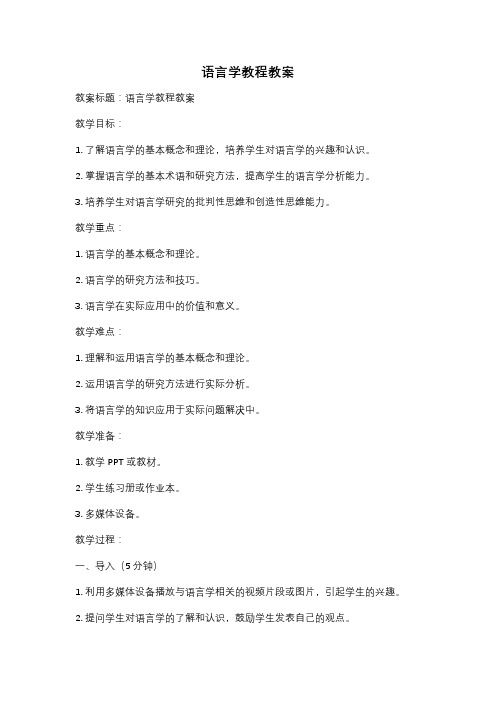
语言学教程教案教案标题:语言学教程教案教学目标:1. 了解语言学的基本概念和理论,培养学生对语言学的兴趣和认识。
2. 掌握语言学的基本术语和研究方法,提高学生的语言学分析能力。
3. 培养学生对语言学研究的批判性思维和创造性思维能力。
教学重点:1. 语言学的基本概念和理论。
2. 语言学的研究方法和技巧。
3. 语言学在实际应用中的价值和意义。
教学难点:1. 理解和运用语言学的基本概念和理论。
2. 运用语言学的研究方法进行实际分析。
3. 将语言学的知识应用于实际问题解决中。
教学准备:1. 教学PPT或教材。
2. 学生练习册或作业本。
3. 多媒体设备。
教学过程:一、导入(5分钟)1. 利用多媒体设备播放与语言学相关的视频片段或图片,引起学生的兴趣。
2. 提问学生对语言学的了解和认识,鼓励学生发表自己的观点。
二、知识讲解(15分钟)1. 介绍语言学的基本概念和理论,如语音学、语法学、语义学等。
2. 解释语言学的研究方法和技巧,如实证研究、对比研究、历史研究等。
3. 引导学生思考语言学在实际应用中的价值和意义,如语言教学、翻译、语音识别等。
三、案例分析(20分钟)1. 提供一个真实的语言学案例,如某个方言的研究或语言变化的分析。
2. 分组让学生对案例进行讨论和分析,运用所学的语言学知识和方法。
3. 鼓励学生提出自己的观点和研究结论,促进学生的批判性思维和创造性思维能力。
四、练习与巩固(15分钟)1. 发放练习册或作业本,让学生进行语言学知识的巩固练习。
2. 教师辅导学生解答练习中的问题,并及时纠正学生的错误。
五、拓展与应用(10分钟)1. 引导学生思考如何将所学的语言学知识应用于实际问题解决中。
2. 提供一些实际问题,让学生运用语言学的方法进行分析和解决。
六、总结与反思(5分钟)1. 总结本节课所学的语言学知识和方法。
2. 鼓励学生发表对本节课的反思和建议。
教学扩展:1. 鼓励学生阅读与语言学相关的书籍和论文,拓宽知识面。
语言学教程文档
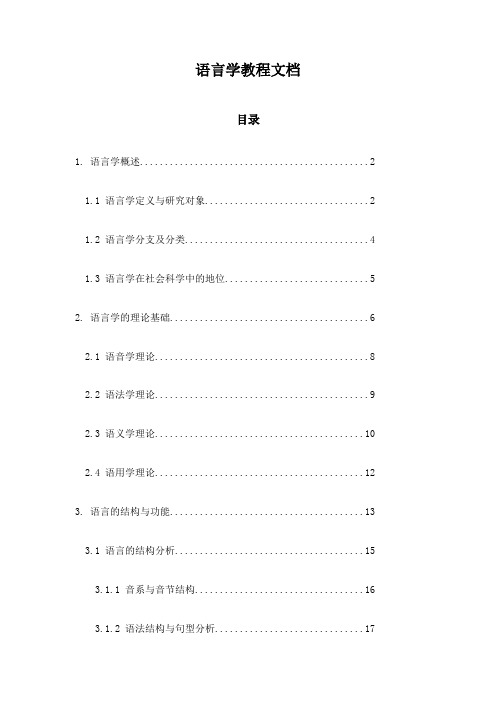
语言学教程文档目录1. 语言学概述 (2)1.1 语言学定义与研究对象 (2)1.2 语言学分支及分类 (4)1.3 语言学在社会科学中的地位 (5)2. 语言学的理论基础 (6)2.1 语音学理论 (8)2.2 语法学理论 (9)2.3 语义学理论 (10)2.4 语用学理论 (12)3. 语言的结构与功能 (13)3.1 语言的结构分析 (15)3.1.1 音系与音节结构 (16)3.1.2 语法结构与句型分析 (17)3.1.3 语义场与语义关系 (18)3.2 语言的功能与运用 (20)3.2.1 语言的交际功能 (22)3.2.2 语言的表达功能 (23)3.2.3 语言的指示功能 (24)4. 语言的发展与社会变迁 (26)4.1 语言发展的规律与特点 (27)4.2 语言与社会的相互关系 (28)4.3 语言的地域差异与方言现象 (30)4.4 语言的接触与融合现象 (31)5. 语言学的应用与实践 (33)5.1 语言与文学的关系 (34)5.2 语言与翻译的实践 (35)5.3 语言与人工智能的发展 (37)5.4 语言学在其他领域的应用 (39)6. 语言学的研究方法与路径 (40)6.1 语言学的研究方法概述 (42)6.2 田野调查与实证研究 (43)6.3 文献资料的搜集与分析 (45)6.4 实验方法与语言学研究实践 (46)7. 结论与展望 (47)7.1 对语言学研究的总结与反思 (48)7.2 未来语言学发展的趋势与展望 (49)1. 语言学概述语言学作为一门研究人类语言的科学,具有悠久的历史和丰富的研究领域。
它主要探讨语言的本质、结构、功能以及语言与社会、文化、心理等方面的关系。
语言学可以分为几个子领域,包括语音学、音系学、形态学、句法学、语义学、语用学等。
语音学关注声音的产生、传播和感知,研究语音的物理属性和生理机制。
音系学则研究音素和音系的分布规律,揭示语音在各种语言中的变化和差异。
胡壮麟语言学教程汉语

《语言学教程》汉语解释第一章 语言的性质语言的性质语言的性质 语言的定义:语言的基本特征(任意性、二重性、多产性、移位、文化传递和互换性);语言的功能(寒暄、指令、提供信息、询问、表达主观感情、唤起对方的感情和言语行为);语言的起源(神授说,人造说,进化说)等。
语言的起源(神授说,人造说,进化说)等。
第二章 语言学语言学语言学定义;研究语言的四大原则(穷尽、一致、简洁、客观);语言学的基本概念(口语与书面语、共时与历时、语言与言学、语言能力与言行运用、语言潜势与语言行为);普通语言学的分支(语音、音位、语法、句法、语义);;语言学的应用(语言学与语言教学、语言与社会、语言与文字、语言与心理学、人类语言学、神经语言学、数理语言学、计算语言学)等。
学)等。
第三章 语音学语音学发音器官的英文名称;发音器官的英文名称;英语辅音的发音部位和发音方法;英语辅音的发音部位和发音方法;英语辅音的发音部位和发音方法;语音学的定义;语音学的定义;发音语音学;发音语音学;听觉听觉语音学;声学语音学;元音及辅音的分类;严式与宽式标音等。
语音学;声学语音学;元音及辅音的分类;严式与宽式标音等。
第四章 音位学音位学音位理论;音位理论;最小对立体;最小对立体;最小对立体;自由变异;自由变异;自由变异;互补分布;互补分布;互补分布;语音的相似性;语音的相似性;语音的相似性;区别性特征;区别性特征;区别性特征;超语段音位学;超语段音位学;音节;重音(词重音、句子重音、音高和语调)等。
音节;重音(词重音、句子重音、音高和语调)等。
第五章 词法学词法学词法的定义;曲折词与派生词;构词法(合成与派生);词素的定义;词素变体;自由词素;粘着词素(词根,词缀和词干)等。
粘着词素(词根,词缀和词干)等。
第六章 词汇学词汇学词的定义;语法词与词汇词;变词与不变词;封闭词与开放词;词的辨认;习语与搭配。
词的定义;语法词与词汇词;变词与不变词;封闭词与开放词;词的辨认;习语与搭配。
语言学教程胡壮麟

知识创造未来
语言学教程胡壮麟
《语言学教程》是由胡壮麟教授编写的一本语言学入门教材。
这本教材系统地介绍了语言学的基本理论和分析方法。
首先,教程
从语言学的起源和发展历程着手,讲解了语言学的研究对象和方法论。
然后,教程逐步介绍了语音学、语法学、语义学、语用学等语
言学的不同分支,并深入探讨了各个分支的理论框架和研究方法。
此外,教程还特别强调了语言变异和语言变迁的研究,以及语言与
社会、语言与文化之间的关系。
《语言学教程》以清晰的逻辑结构和简明易懂的语言风格著称。
它
不仅适合作为语言学专业的教材使用,也适合作为其他相关学科的
参考书。
此外,教程还包含大量的案例分析和习题,供学生巩固知
识和提高分析能力。
胡壮麟教授是中国著名的语言学家,具有丰富的教学和研究经验。
他在编写《语言学教程》时,借鉴了国内外许多经典的语言学教材,结合自己的教学体验,使得这本教材内容全面、系统、易于理解。
1。
- 1、下载文档前请自行甄别文档内容的完整性,平台不提供额外的编辑、内容补充、找答案等附加服务。
- 2、"仅部分预览"的文档,不可在线预览部分如存在完整性等问题,可反馈申请退款(可完整预览的文档不适用该条件!)。
- 3、如文档侵犯您的权益,请联系客服反馈,我们会尽快为您处理(人工客服工作时间:9:00-18:30)。
1.定义特征:那些决定了人类语言性质的特征被我们称为定于特征。
P32.任意性(索绪尔):指语言符号的形式与所表示的意义没有天然的联系。
P33.所谓句法学,是指依据句法规定建构句子的方法。
P44.二层性是指拥有两层结构的这种特性,上层结构的单位由底层结构的元素构成,每层都有自身的组合规则。
—Lyons P5、P295.音节是讲话时的最小单位,是成百上千词语的片段—语素的承载者。
P56.移位性是指人类语言可以让使用者在交际时用语言符号代表时间上和空间上并不可及的物体、时间或观点。
P67.雅格布逊认为,语言像任何符号系统一样,首先是为了交际。
P78.音位是语言中能够区分意义的最小的语音单位,英语大概有四十五个音位。
P139.辅音根据发音部位和发音方式进行描写,元音依据它们位置的前后进行描写。
P4110.区别特征—雅格布逊—20世纪40年代P4111.超音段特征指语音问题中涉及超出单音音段以上的方面,超音段特征主要有音节、重音、声调和语调。
P4412.形态学是涉及语素的系统研究,是语言学的一个分支。
它研究词的内部结构和构造规则。
P5813.屈折变化指通过附加屈折词缀(如数、人称、有定性、体和格)来表现语法关系;附加词缀并不会改变被附加词的语法类。
P6114.英语中,每个词通常有一个生成性的屈折词缀,但可能有多个派生词缀。
P6415.音位变化是指因为语音上的变化而导致的形式变化。
P77(脱落、添加、换位、同化)16.和树形图相比,括号法不那么常用,但不失为一种标注语法单位成分结构的便捷方法。
P8917.句法功能是指一种语言形式和同一句型中的其他部分之间的关系。
功能的名称通常有主语、宾语、谓语、修饰语、补语等。
P9218.递归性和开放性一般被看作语言创造性的核心。
P10119.嵌入:从句的三种基本类型包括宾语从句、状语从句和关系从句。
P10220.把词语意义跟它所指称或所代表的事物联系起来的理论,叫做指称论。
P10821.人们一般公认的三种涵义关系:相同关系(同义关系)、对立关系(反义关系)、内包关系(上下义关系)。
P11022.句子意义由其中词语的意义及组合方式所决定,这一观点通常叫做组合性原则。
P11923.认知是指心理过程或知识的能力,包括意识、知觉、推理和判断等。
目前,有三种语言与认知的研究方法,即形式方法。
心理学方法和认知方法。
P13024.指示词是一种从说话环境出发,指向某物的语言形式。
P14325.“萨丕尔—沃尔夫假说”:这个假说认为,语言塑造了我们的思维模式,相应地,不同的语言表达决定了人们认识世界方式的不同。
从这个观点出发,可以得到两点认识:一方面,语言可以决定我们的思维方式;另一方面,语言之间的相似性是相对的,结构性差异越大,反映出对于世界的认识越不同。
因此,这个假说也被称作“语言决定论”和“语言相对主义”。
P16226.Watergate P16827.莱考夫—女子英语文体形式P17128.20世纪70年代以来,随着社会语言学家海姆斯“交际能力”理论的提出,形成了对于传统语言教学方法的严肃挑战。
P17329.心理学家罗杰斯声称,真正的交流建立在理解接触上的倾听。
P17430.心理学家罗杰斯提出的“三大交际原则”:①学会从对方的角度看待事物;②学会从对方的角度感受事物;③学会从对方的角度了解世界。
P17431.言语行为理论是牛津哲学家奥斯汀提出的,是研究语言使用的第一个重要理论。
P18332.“广义语言能力”包括感觉运动系统、概念意念系统以及递归运算机制三个方面的研究内容,它为我们提供了从有限元素组群生成无限表达方式的可能;“狭义语言能力”仅含递归特征。
有理由认为,“广义语言能力”可能来自于语言之外的进化动因。
P179 33.奥斯汀提出自己理论的第一步是把句子分成两类:施为句和叙事句。
并不是用来描述事物的,它们没有真假。
说出这些句子就是,或者部分是,实施某种行为。
这些句子称为施为句,其中的动词叫施为性动词。
P18434.语用学中第二个重要的理论就是会话含义理论,由牛津大学的另一位哲学家格莱斯提出。
P18735.“使你所说的话,在其所发生的阶段,符合你所参与的交谈的公认目标或方向。
”—合作原则(CP)P18836.会话含义:它是一种暗含意义,可以在合作原则及其准则的指导下,在词语的常规意义基础上,联系语境推导出来。
在这种意义上,会话含义相当于言语行为理论中的行事语力。
它们都与意义的语境方面有关,用汉语的说法,就是“言外之意”。
P19437.关联原则:每一个明示交际行动,都传递一种假定:该行动本身具备最佳关联性。
(1986,斯波伯,威尔逊)P19438.霍恩—1984—Q原则,R原则。
Q原则源于格莱斯的数量准则第一条次则,R原则源于关系准则。
P19739.Q原则与内容有关。
R原则与形式有关。
P19840.莱文森—1987—数量原则,信息量原则,方式原则。
他把数量准则第二条次则重新命名为“信息量原则”,简写为I原则;数量准则第一条次则命名为“数量原则”,简写为Q 原则。
P20141.前景化的概念来自于视觉艺术,与“背景”一词相对应,已经成为文体学的常用术语。
它被定义为“以艺术手法为动机的偏离”。
42.转喻意味着“名称的改变”。
P21343.明喻是把一种事物和另一种事物作比较,并通过展现一种事物如何与另一事物相似来解释这种事物是什么样子的方法。
它用as或like(像,好像,好似,如)等词在文本中作为明确标志。
P21344.提喻:更深层次的比喻语言是提喻。
它通常被视为转喻的一种,是指用事物一部分的名称来指代整个事物,反之亦可。
P21345.头韵Cvc 准押韵cVc 辅音韵cvC 反韵CVc 副韵CvC P21646.语域是语言学里用来描述一种特定的语言风格及其语境之间关系的术语。
P23247.意象图式大致可描述为我们日常的感知交往和身体经验的反复呈现模式。
P23448.语料库:一个语言数据的集合,可以由书面文本构成,也可以由录音言语的转写本构成。
P24949.Chomsky认为一种语言的句法规则是有限的。
50.根据Krashen的输入假设,学习者主要通过理解语言输入来实现。
Krashen提出的i+1理论认为,学习者接触的语言应该略微高于他们的现有水平,这样他们既可以理解其中的大部分内容,又可以面对一定的挑战,从而争取更大的进步。
P26551.正处于学习过程的二语或外语学习者构建的语言通常被称为中介语。
P26652.建构主义的语言观认为,学习语言(或者任何其他知识)都是一个社会建构的过程。
P26653.中介语通常被理解为介于目的语和学习者母语之间的语言。
与目的语相比,中介语还不够完善,但它也不只是学习者母语的简单翻译。
中介语是一个动态的语言系统,它不断地从初级水平向地道的母语水平发展。
因此,中介语的“中介”实际上表示的是在开始阶段和最终阶段之间。
P26754.交际能力是指学习者在具体的语境中恰当并且有效的运用语言进行交际的能力。
交际能力包括语法词汇知识、会话规则以及怎样运用和回答不同类型的言语行为和社会习俗,以及怎样恰当得体地运用语言。
P26855.教学大纲类型:结构教学大纲、情景教学大纲、交际教学大纲、任务型教学大纲。
56.对母语作用的研究通常被称作语言迁移研究,语言迁移指先前学习的心理过程转移至新的学习环境,或者指“由于目的语与先前(可能不完全)习得的其他任何一门语言之间的异同所导致的影响”。
例如,学生在母语中掌握的知识和技能可以迁移到第二语言或外语中。
P27957.对比分析是通过对比不同语言(如第一语言和第二语言)来确定潜在错误的方法,从而把第二语言学习环境下必须学习的和不必学习的东西最终区分开来。
对比分析的目的是为了预测哪些领域容易学得,哪些领域不易学得。
P27958.错误分析的主要主张是,第二语言学习者所犯的许多错误,除了第一语言的影响外,还有其他因素的影响。
P28059.根据错误来源,错误经常分为语际错误和语内错误。
P28060.错误分析步骤:①识别错误;②描述错误;③解释错误。
P28161.这个符号是形式和思想的结合,索绪尔称之为“能指”和“所指”。
P28762.韩礼德认为,句子是概念意义、人际意义和语篇意义同步体现的产物。
P30363.韩礼德认为,尽管语言的言语角色千变万化,但它最基本的任务只有两个:给予和求取。
P30164.S:外部刺激r:言语的代替反映s:言语的代替性刺激R:外部的实际反映(S→r……s→R)65.兰姆说,语言的本质就是把声音与意义相结合,或把意义与声音相结合;虽然关系很复杂,但可以被看作一系列相连在一起的层次系统。
每个层次系统都有在自己这个层次上的结合规则,不同的层次都在实现的基础上相互连接。
P31066.乔姆斯基认为,语言习得机制可能含有三个成分:进行假设的机制、语言普遍性和评价程序。
P31267.乔姆斯基把转换规则区分为两种:强制性的和可选择性的。
P31568.格语法是着重研究句子成分之间关系的分析方法。
它是菲尔墨20世纪60年代末发展起来的生成语法的一种。
在该语法里,动词被视为句子中最为重要的部分,与众多不同的名词短语有着一系列的关系。
这些关系称为“格”。
P322——《语言学教程》(第三版中文版)胡壮麟(个人整理以供参考)。
